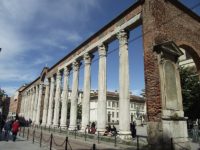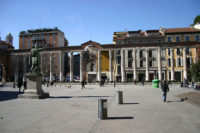When visiting Milan, you may stumble upon an ancient relic that stands as a testament to the city’s rich history: the Colonne di San Lorenzo. This article will take you on a journey through time, exploring the historical and architectural significance of these columns and their surrounding area. So, let’s embark on this adventure together and uncover the secrets of the Colonne di San Lorenzo!
History of Colonne di San Lorenzo
The Colonne di San Lorenzo date back to the late 2nd to early 3rd century AD, during the Roman Empire. They were originally part of a larger complex that included a bathhouse and a basilica. The columns were moved to their current location in the 4th century AD to make way for the construction of the Basilica di San Lorenzo Maggiore.
During the Middle Ages, the columns served as a gathering place for various events, including markets and religious processions. They also played a crucial role in defining the city’s layout, as they marked the southern boundary of Milan.
Restoration and modern times
Over the centuries, the Colonne di San Lorenzo suffered from weathering and pollution. In the 1930s, a restoration project was undertaken to preserve these ancient treasures. Today, the site is a popular destination for tourists and locals alike.
Architectural Features
Corinthian columns: The Colonne di San Lorenzo is a row of 16 marble Corinthian columns, standing around 8 meters tall. They are intricately carved and topped with ornate capitals, showcasing the skill and craftsmanship of Roman sculptors.
Basilica di San Lorenzo Maggiore Adjacent to the columns, you’ll find the Basilica di San Lorenzo Maggiore, a historic church that dates back to the 4th century AD. Its unique blend of architectural styles, from Romanesque to Baroque, is a testament to the city’s diverse history.
Archi di Porta Ticinese: Close by, the Archi di Porta Ticinese is another notable architectural feature. These triumphal arches, dating back to the 16th century, once served as a gateway into the city.
Cultural Significance
The Colonne di San Lorenzo has been a vital part of Milanese culture for centuries. It has served as a gathering place for various events and continues to be a popular spot for socializing, particularly during the warmer months.
Surrounding Area
Parco delle Basiliche: Located nearby is the Parco delle Basiliche, a green oasis in the heart of Milan. The park is home to the Basilica di San Lorenzo Maggiore and the Basilica of Sant’Eustorgio, two of the city’s most important religious sites. The park offers a tranquil respite from the bustling streets of Milan, making it the perfect place to relax and enjoy the beauty of the Colonne di San Lorenzo.
Navigli district: The Navigli district, famous for its picturesque canals and vibrant nightlife, is also within walking distance of the Colonne di San Lorenzo. The area is a popular destination for dining, shopping, and enjoying aperitivo, the Italian tradition of pre-dinner drinks and appetizers.
Corso di Porta Ticinese: Corso di Porta Ticinese is a lively shopping street located near the Colonne di San Lorenzo. The street is home to an array of boutiques, antique shops, and trendy bars, offering a unique shopping experience for visitors and locals alike.
Nightlife and Events
The area surrounding the Colonne di San Lorenzo is known for its vibrant nightlife, with a variety of bars, clubs, and restaurants catering to different tastes. In the summer months, the square in front of the columns comes alive with outdoor events and live music performances, drawing crowds from all over the city.
Visiting Colonne di San Lorenzo
How to get there: The Colonne di San Lorenzo is easily accessible by public transportation. The nearest metro station is Sant’Ambrogio (Line M2), a 10-minute walk away. Alternatively, you can take tram 3 or 9, which stop directly in front of the columns.
When to visit: The site is open to the public 24/7 and is particularly enchanting in the evening when the columns are illuminated. The best time to visit is during the spring and summer months, when the weather is pleasant, and outdoor events are held in the area.
Guided tours: While it is possible to explore the Colonne di San Lorenzo independently, guided tours can provide valuable insight into the history and significance of the site. Several companies offer walking tours that include the Colonne di San Lorenzo and other nearby attractions.
Other Attractions Nearby
In addition to the Colonne di San Lorenzo, Milan offers a wealth of cultural and historical attractions. Some notable sites nearby include the iconic Cathedral of Milan (Duomo di Milano), the historic Sforza Castle, and the renowned Leonardo da Vinci’s Last Supper, housed in the Convent of Santa Maria delle Grazie.
























